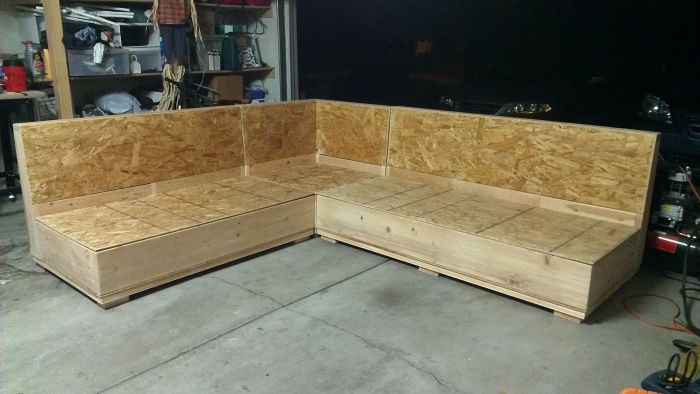DIY sectional couch projects are gaining popularity as homeowners seek to create custom furniture that reflects their unique style and budget. Building your own sectional couch allows for complete control over design, materials, and features, leading to a piece that perfectly complements your living space. This project may seem daunting, but with careful planning, the right tools, and a bit of patience, you can create a stunning and functional sectional couch that you’ll cherish for years to come.
This comprehensive guide will walk you through every step of the process, from choosing the right materials and designing your dream sectional to tackling the construction and upholstery. We’ll cover essential techniques, safety considerations, and cost-saving tips to ensure your DIY sectional couch project is a success.
DIY Sectional Couch

Building your own sectional couch can be a rewarding and fulfilling project. It allows you to create a piece of furniture that perfectly fits your space and style, while potentially saving money compared to purchasing a pre-made sectional.
Reasons for Building a DIY Sectional Couch
The appeal of creating a sectional couch yourself lies in the ability to tailor it to your specific needs and preferences. This involves several benefits:
- Cost Savings: DIY projects often result in significant cost savings compared to buying a ready-made sectional. By sourcing materials yourself and avoiding retail markups, you can potentially save a considerable amount of money.
- Customization: A DIY sectional allows for complete customization. You can choose the exact dimensions, fabric, and design elements to perfectly match your existing décor and create a truly unique piece.
- Satisfaction: The process of building a sectional couch from scratch can be immensely satisfying. It allows you to showcase your creativity and woodworking skills while creating a piece of furniture that you can be proud of.
Examples of Unique Sectional Couch Designs
The possibilities for unique sectional couch designs are endless when you embrace a DIY approach. Here are some examples:
- Modular Sectional: This design features individual pieces that can be arranged in various configurations to suit different needs and spaces. For instance, you can create a large L-shaped sectional for a spacious living room, or separate the pieces to create smaller seating arrangements.
- Built-in Storage: Incorporate storage compartments within the sectional frame to maximize space and keep clutter under control. This can be achieved by adding drawers, shelves, or even hidden compartments beneath the seating cushions.
- Unique Shapes: Break free from traditional rectangular shapes and experiment with curved, circular, or even asymmetrical designs. This can create a truly distinctive and eye-catching sectional that becomes a focal point in your living room.
Frame Construction Techniques

Building a sturdy and durable frame is crucial for any sectional couch. The choice of materials and construction methods will significantly impact the couch’s longevity, comfort, and overall aesthetic. Here’s a breakdown of the most common frame construction techniques, their pros and cons, and a design example.
Wood Framing
Wood framing is a classic and versatile method for building furniture frames. Hardwoods like oak, maple, or walnut are known for their strength and durability. Softwoods like pine or fir are more affordable but may require additional reinforcement.
- Pros:
- Relatively inexpensive
- Easy to work with, allowing for custom shapes and designs
- Strong and durable when properly constructed
- Can be easily repaired or modified
- Cons:
- Susceptible to warping, cracking, or rotting if not properly treated or sealed
- Requires careful joinery and assembly to ensure stability
- Heavy and may require additional support for larger frames
Metal Framing
Metal framing, often using steel or aluminum, offers a robust and long-lasting alternative to wood. It’s frequently employed in modern furniture designs for its sleek aesthetics and strength.
- Pros:
- Extremely strong and resistant to warping, cracking, and rotting
- Lightweight compared to wood frames, making them easier to move and assemble
- Can be easily welded or bolted together, allowing for intricate designs
- Durable and resistant to pests and moisture
- Cons:
- More expensive than wood framing
- Requires specialized tools and welding equipment for assembly
- Can be prone to rusting if not properly treated
Combination Framing, Diy sectional couch
Combining wood and metal framing techniques offers a blend of strengths, often incorporating the durability of metal for critical support points and the flexibility of wood for decorative elements.
- Pros:
- Leverages the best features of both materials, resulting in a strong and versatile frame
- Allows for creative design solutions, combining the aesthetic appeal of wood with the strength of metal
- Can be more cost-effective than using only metal framing
- Cons:
- Requires careful planning and execution to ensure compatibility between materials
- May involve more complex joinery and assembly techniques
Frame Structure Design Example
- Sectional Couch with Combination Framing: A sectional couch can be constructed using a combination of hardwood for the frame’s main structure and steel for the legs and support brackets. The hardwood frame can be assembled using mortise and tenon joints, ensuring stability and strength. Steel legs and brackets can be welded to the hardwood frame, providing additional support and a contemporary aesthetic.
Building a DIY sectional couch is a rewarding project that allows you to express your creativity and save money. From choosing the perfect fabric to crafting a sturdy frame, each step of the process contributes to a unique and personalized piece of furniture. With the right planning, tools, and a touch of ingenuity, you can transform your living space with a custom-built sectional couch that perfectly suits your needs and style.
A DIY sectional couch can be a great way to add personality and comfort to your living room. If you’re looking for a way to store your books and magazines, consider building some DIY pallet shelving to complement your new couch. You can even use the same pallet wood to create a matching coffee table, adding a cohesive and rustic touch to your space.
